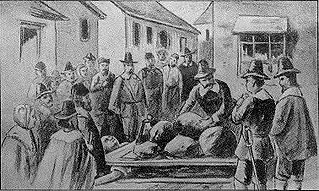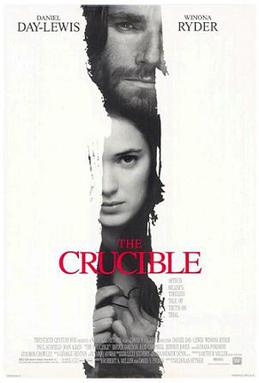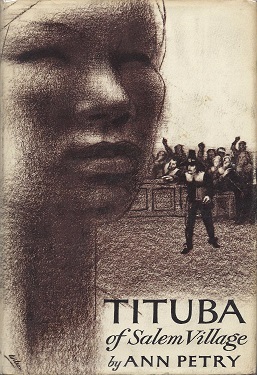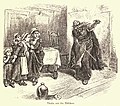
The Crucible is a 1953 play by the American playwright Arthur Miller. It is a dramatized and partially fictionalized story of the Salem witch trials that took place in the Massachusetts Bay Colony during 1692–93. Miller wrote the play as an allegory for McCarthyism, when the United States government persecuted people accused of being communists. Miller was questioned by the House of Representatives' Committee on Un-American Activities in 1956 and convicted of contempt of Congress for refusing to identify others present at meetings he had attended.

The Salem witch trials were a series of hearings and prosecutions of people accused of witchcraft in colonial Massachusetts between February 1692 and May 1693. More than 200 people were accused. Thirty people were found guilty, nineteen of whom were executed by hanging. One other man, Giles Corey, died under torture after refusing to enter a plea, and at least five people died in jail.
Abigail Williams was an 11- or 12-year-old girl who, along with nine-year-old Betty Parris, was among the first of the children to falsely accuse their neighbors of witchcraft in 1692; these accusations eventually led to the Salem witch trials.
Elizabeth "Betty" Parris was one of the young girls who accused other people of being witches during the Salem witch trials. The accusations made by Parris and her cousin Abigail Williams caused the direct death of 20 Salem residents: 19 were hanged, while another, Giles Corey, was pressed to death.
John Hathorne was a merchant and magistrate of the Massachusetts Bay Colony and Salem, Massachusetts. He is best known for his early and vocal role as one of the leading judges in the Salem witch trials.
John Proctor was a landowner in the Massachusetts Bay Colony. He and his wife Elizabeth were tried and convicted of witchcraft as part of the Salem Witch Trials, whereupon he was hanged.

Giles Corey was an English farmer, petty thief, and tried murderer who was accused of witchcraft along with his wife Martha Corey during the Salem witch trials. After being arrested, Corey refused to enter a guilty or not guilty plea. He was subjected to pressing in an effort to force him to plead and died after three days of this torture. Because Corey refused to enter a plea, his estate passed on to his sons instead of being seized by the local government.

John Hale was the Puritan pastor of Beverly, Massachusetts, and took part in the Salem witch trials in 1692. He was one of the most prominent and influential ministers associated with the witch trials, being noted as having initially supported the trials and then changing his mind and publishing a critique of them.

Samuel Parris was the Puritan minister in Salem Village, Massachusetts, during the Salem witch trials. Accusations by Parris and his daughter against an enslaved woman precipitated an expanding series of witchcraft accusations.

Tituba was a Native American slave woman who was one of the first to be accused of witchcraft during the Salem witch trials of 1692–1693.

The Crucible is a 1996 American historical drama film directed by Nicholas Hytner and written by Arthur Miller, based on his 1953 play of the same title. It stars Daniel Day-Lewis as John Proctor, Winona Ryder as Abigail Williams, Paul Scofield as Judge Thomas Danforth, Joan Allen as Elizabeth Proctor, and Bruce Davison as Reverend Samuel Parris. Set in 1692 during the Salem witch trials, the film follows a group of teenage girls who, after getting caught performing a ritual in the woods, band together and falsely accuse several of the townspeople of witchcraft.

Sarah Good was one of the first three women to be accused of witchcraft in the Salem witch trials, which occurred in 1692 in colonial Massachusetts.

Martha Corey was accused and convicted of witchcraft during the Salem witch trials, on September 9, 1692, and was hanged on September 22, 1692. Her second husband, Giles Corey, was also accused and killed.
Mary Ann Warren was an accuser and later confessed witch during the 1692 Salem witch trials. She was a servant for John and Elizabeth Proctor. Renouncing her claims after threats of beating from her master, she was later accused and arrested for allegedly practicing witchcraft herself, after which she again became afflicted and accused others of witchcraft. Her life after the trials is unknown.
Sarah Osborne (also variously spelled Osbourne, Osburne, or Osborn; née Warren, formerly Prince, was a colonist in the Massachusetts Bay colony and one of the first women to be accused of witchcraft in the Salem witch trials of 1692. Sarah Osborn was suggested to be a witch by Sarah Good. Sarah Good said she had been tormenting the girls.

Mercy Lewis was an accuser during the Salem Witch Trials. She was born in Falmouth, Maine. Mercy Lewis, formally known as Mercy Allen, was the child of Philip Lewis and Mary (Cass) Lewis.
This timeline of the Salem witch trials is a quick overview of the events.

Tituba of Salem Village is a 1964 children's novel by African-American writer Ann Petry about the 17th-century West Indian slave of the same name who was the first to be accused of practicing witchcraft during the 1692 Salem witch trials. Written for children 10 and up, it portrays Tituba as a black West Indian woman who tells stories about life in Barbados to the village girls. These stories are mingled with existing superstitions and half-remembered pagan beliefs on the part of Puritans, and the witchcraft hysteria is partly attributed to a sort of cabin fever during a particularly bitter winter. Petry's portrayal of the helplessness of women in that period, particularly slaves and indentured servants, is key to understanding her view of the Tituba legend.

Elizabeth Booth was born in 1674 and was one of the accusers in the Salem Witch Trials. She grew up in Salem, Massachusetts, as the second eldest of ten children. When she was sixteen she was accused of being a witch. When she was eighteen, she began accusing people of practicing witchcraft, including John Proctor, Elizabeth Proctor, Sarah Proctor, William Proctor, Benjamin Proctor, Woody Proctor, Giles Corey, Martha Corey, Job Tookey, and Wilmont Redd. Five of these people were executed due to Booth's testimony. Elizabeth Proctor would have been executed as well if she was not pregnant. After the Witch Trials, Booth married Israel Shaw on December 26, 1695, and had two children named Israel and Susanna. Booth's death date is unknown.
















































